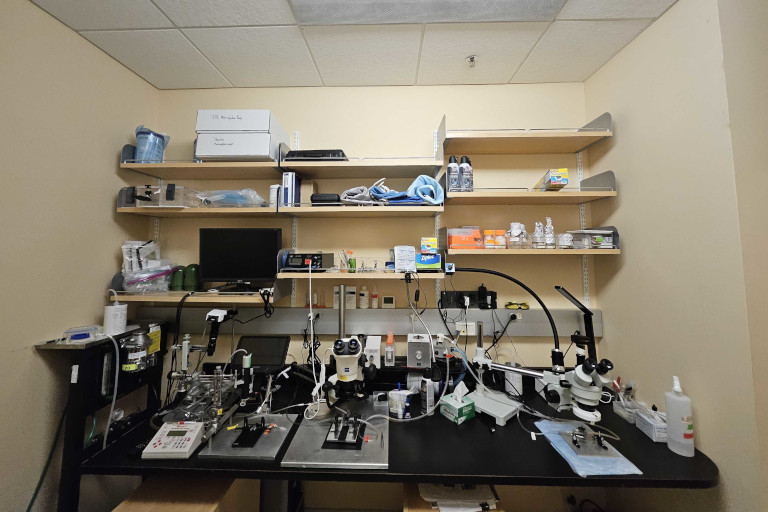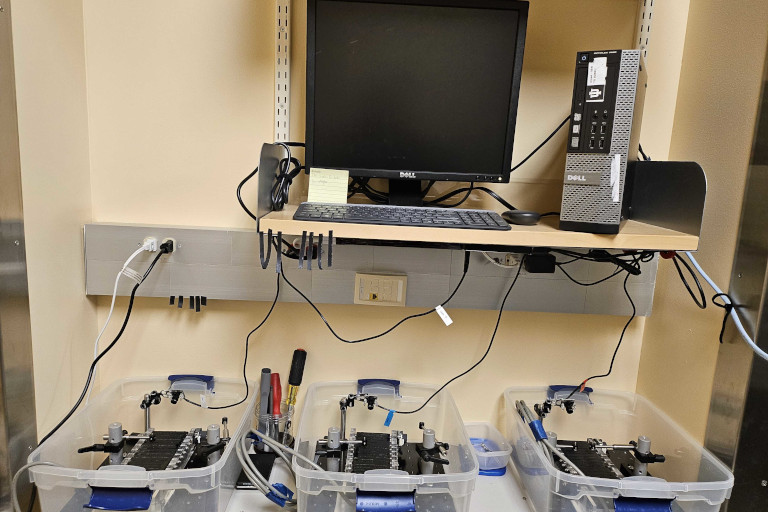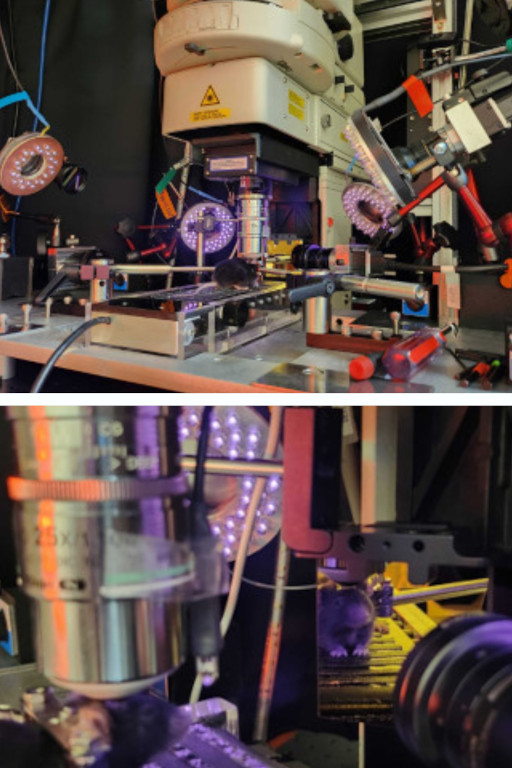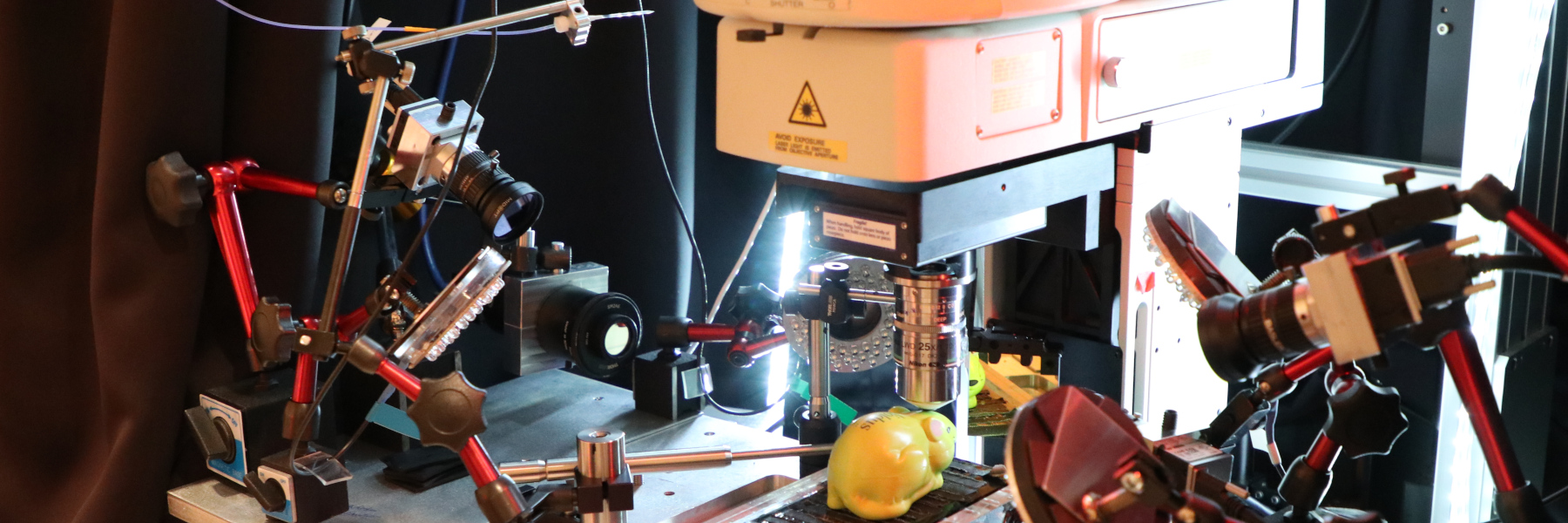Indiana University Bloomington, Center for Cannabis, Cannabinoids, & Addiction
Overview
Our imaging core provides the following two technically advanced imaging paradigms for approved investigators:
- Applying the ScaleS optical clearing method and two-photon (2P) imaging to examine the impact of phytocannabinoids or other illicit drugs on long-range axonal projections in 3D
- Using longitudinal in vivo 2P imaging for Ca2+ and selected sensor responses of awake behaving mice to determine the mesoscale physiological changes in brain circuits elicited by chronic exposure to drugs of abuse.
The Nikon A1R MP+ multi-photon microscope boasts a cutting-edge configuration, featuring dual lines InSight DeepSee infrared pulsed lasers (Spectra-Physics Inc.). One of these lasers offers tunable wavelength capabilities within the range of 820-1300nm, while the other maintains a fixed wavelength at 1040nm. The incorporation of dual-line lasers facilitates simultaneous, two-color excitation, enhancing the microscope's capability for multiplex imaging. This A1RMP+ system is equipped with both resonant and galvano scanners, providing investigators with the flexibility to capture images at a high imaging rate and/or achieve optimal anatomical resolution tailored to their experimental requirements.
Available Imaging Methodologies
ScaleS Imaging
To assist investigators in quantitatively determining the impacts of cannabis or other substance use disorders on axonal trajectories and innervation patterns, we have established ScaleS methodology to preserve fluorescence and optimized 2P imaging of thick brain sections. Selected axonal tracts can be genetically labeled with fluorescence by employing stereotaxic-aided AAV injections or by generating transgenic mice. Specifically, brains will be sliced into 1 mm-thick coronal brain sections following ScaleS clearing. Post-cleared brain sections will be mounted in 100 mm diameter Petri dishes filled with fresh ScaleS4(D25) solution and then imaged at 1µm intervals in the z-axis with a 10X/NA 0.5 Multi-Immersion Clarity objective lens. Depending on the image area, imaging takes 15 ~ 20h/slice. Axonal projections will be reconstructed by the 3-D Surface module of the Imaris software (Bitplane Inc.). Various measurements, including volume, lengths, ellipticity prolate, and ellipticity oblate, can be extracted for selected axonal projections within defined brain regions. The comprehensive and large data sets generated here will be shared with the scientific community to explore 3D trajectories further.


In vivo 2P Ca2+ and Selected Sensor Imaging
In vivo 2P Ca2+ and selected sensor smaging (such as endogenous cannabinoid sensor) of awake-behaving mice.
The core facility is equipped with a specialized surgery suite featuring a customized stereotaxic apparatus tailored for surgical interventions in neonatal pups and adult mice. For training purposes, we offer four dedicated stations equipped with voluntary treadmills capable of simultaneously accommodating adult mice for awake imaging training. In vivo sensor signal will be imaged with a 25X/NA 1.1 Water Immersion objective lens. During sensor imaging sessions, comprehensive behavioral data are captured through the utilization of four cameras. These include Basler cameras (a2A1920-160umBAS) for monitoring body part movements, Teledyne cameras (FL3-U3-13Y3M) for tracking whisker movements, and pupil dynamics—all illuminated with an 850 nm IR LED light source. Imaging data registered to electronic lab notebooks will be available to investigators. To enhance our behavioral analysis capabilities, we leverage advanced tools such as Facemap, DeeplabCut, and Anipose. We also have established a Cloud-based data analysis pipeline with DataJoint. Investigators can work with DataJoint to upload datasets into their server and conduct data analyses through our established pipelines.

Project Opportunities
C3A MSIC-Multi-Photon Microscopy Core will provide support for one or two ScaleS-2P projects and/or one in vivo 2P project per year.
Investigators are strongly encouraged to consult with MSIC-MPM PI, Dr. Hui-Chen Lu, before submitting a proposal to ensure compatibility of the proposal with the Core’s capabilities.
Eligibility
- Trainees and PIs working in or moving into the substance use disorder
- Well-developed research plan designed to address significant questions related to substance use disorders and provide preliminary data for grant applications.
- Clear rationale on how the experimental data generated by the imaging core will answer a research question.
- For proposals proposing an in vivo MP experiment, identification of a qualified scientist from the PI’s lab who can physically be in Bloomington for the duration of the funded experiment.
- Clear plan to analyze and summarize data in timely manner.
- Agreement to share the data generated with the greater scientific community once results are published.
Proposal Review
Each proposal will first be reviewed by the core PI for suitability. Proposals deemed suitable will be reviewed by the C3A steering committee. Dr Lu will work with steering committee to select projects based on scientific value, projected impact on the substance use disorder field, and feasibility. All applicants will receive feedback on their proposal and will be offered the opportunity to be mentored by a C3A PI or Affiliate in subsequent applications to the C3A or external agencies. One or two ScaleS-2P projects and/or one in vivo 2P project will be served per year.
Proposals will be ranked by the following criteria:
1. A clear rationale on how the proposed research project will benefit from access to the MSIC core and will address substance use disorders.
2. A well thought-out experimental plan on how data generated from MSIC core will benefit a grant proposal and/or provide key data for a manuscript in preparation.
3. The impact of data generated by the MSIC core on the applicant’s ongoing research program. Low priority will be given to proposals that merely supplement ongoing research.
4. Data from MSIC core will be critical for the PI’s NIDA (or other relevant funding agency) grant application.
5. Readiness to conduct the proposed experiment, such as the availability of essential mouse lines and/or key reagents for the proposed experiment.
6. A clear plan and commitment to execute the proposed experiment. For in vivo 2P imaging experiments, it is required to have a designated senior researcher who is committed to conduct experiments in the C3A core at a specific time. This person should have demonstrated expertise in mouse surgical procedures.
7. Agreement to give a short presentation of the project at least three times (typically, before the project starts, in the middle of the project, and at the end of the project) to the monthly C3A research meetings and once to the external advisory board (EAB) at the annual EAB meeting. A summary report will be prepared when the project is completed.
Acknowledgements
Disclaimer
Research and content found in this publication is supported by the National Institute On Drug Abuse of the National Institutes of Health under Award Number P30DA056410. The content is solely the responsibility of the authors and does not necessarily represent the official views of the National Institutes of Health.


